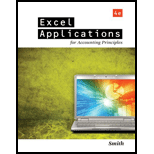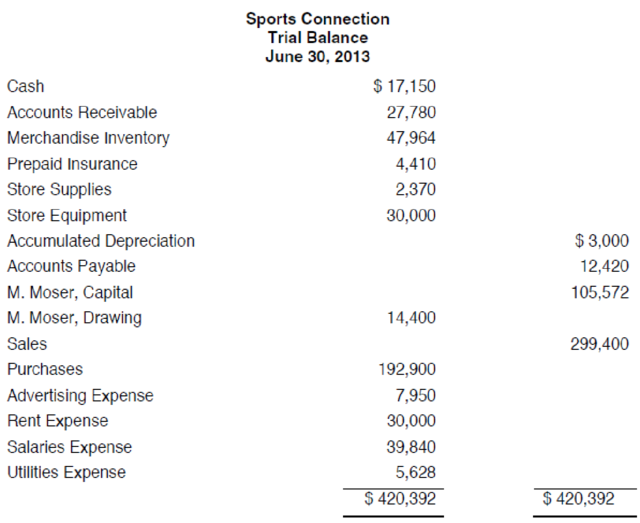
Excel Applications for Accounting Principles
4th Edition
ISBN: 9781111581565
Author: Gaylord N. Smith
Publisher: Cengage Learning
expand_more
expand_more
format_list_bulleted
Concept explainers
Textbook Question
Chapter 3, Problem 1R
The

Adjustment information is as follows:
- a. Supplies on hand as of June 30, 2013, $450.
- b. Insurance premiums that expired during the year, $2,420.
- c.
Depreciation on equipment during the year, $1,500. - d. Included in the rent expense of $30,000 is $1,200 that is prepaid for July 2013.
- e. Salaries accrued but not paid at June 30, 2013, $1,440.
- f. Merchandise inventory on June 30, 2013, $68,864.
As the accountant for Sports Connection, you have been asked to prepare
Expert Solution & Answer
To determine
Prepare adjusting entries and financial statement by making entries in worksheet.
Explanation of Solution

Want to see more full solutions like this?
Subscribe now to access step-by-step solutions to millions of textbook problems written by subject matter experts!
Students have asked these similar questions
What markup percentage is the company using
An asset owned by Crescent Manufacturing has a book value of $36,000 on June 30, Year 5. The asset has been depreciated at an annual rate of $8,000 using the straight-line method. Assuming the asset is sold on June 30, Year 5 for $39,500, how should the company record the transaction? a. Neither a gain nor a loss is recognized on this type of transaction. b. A gain on sale of $3,500. c. A gain on sale of $5,000. d. A loss on sale of $3,500. e. A loss on sale of $5,000.
Can you solve this financial accounting question with the appropriate financial analysis techniques?
Chapter 3 Solutions
Excel Applications for Accounting Principles
Ch. 3 - The trial balance of Sports Connection at June 30,...Ch. 3 - The trial balance of Sports Connection at June 30,...Ch. 3 - The trial balance of Sports Connection at June 30,...Ch. 3 - The trial balance of Sports Connection at June 30,...Ch. 3 - The trial balance of Sports Connection at June 30,...Ch. 3 - Open P2WORK4 and click the Chart sheet tab. On the...
Knowledge Booster
Learn more about
Need a deep-dive on the concept behind this application? Look no further. Learn more about this topic, accounting and related others by exploring similar questions and additional content below.Similar questions
- Can you solve this general accounting question with the appropriate accounting analysis techniques?arrow_forwardPlease provide the correct answer to this general accounting problem using valid calculations.arrow_forwardCornell Manufacturing has stockholders' equity of $420,000 and total liabilities of $380,000. What is the value of total assets?arrow_forward
- I am searching for the accurate solution to this general accounting problem with the right approach.arrow_forwardI need help solving this general accounting question with the proper methodology.arrow_forwardIf a business buys supplies on credit, which of the following accounts will be affected?a) Supplies and Accounts Payableb) Cash and Suppliesc) Accounts Receivable and Suppliesd) Supplies and Cashno aiarrow_forward
arrow_back_ios
SEE MORE QUESTIONS
arrow_forward_ios
Recommended textbooks for you
 Intermediate Accounting: Reporting And AnalysisAccountingISBN:9781337788281Author:James M. Wahlen, Jefferson P. Jones, Donald PagachPublisher:Cengage LearningPrinciples of Accounting Volume 1AccountingISBN:9781947172685Author:OpenStaxPublisher:OpenStax College
Intermediate Accounting: Reporting And AnalysisAccountingISBN:9781337788281Author:James M. Wahlen, Jefferson P. Jones, Donald PagachPublisher:Cengage LearningPrinciples of Accounting Volume 1AccountingISBN:9781947172685Author:OpenStaxPublisher:OpenStax College College Accounting (Book Only): A Career ApproachAccountingISBN:9781337280570Author:Scott, Cathy J.Publisher:South-Western College Pub
College Accounting (Book Only): A Career ApproachAccountingISBN:9781337280570Author:Scott, Cathy J.Publisher:South-Western College Pub

Intermediate Accounting: Reporting And Analysis
Accounting
ISBN:9781337788281
Author:James M. Wahlen, Jefferson P. Jones, Donald Pagach
Publisher:Cengage Learning

Principles of Accounting Volume 1
Accounting
ISBN:9781947172685
Author:OpenStax
Publisher:OpenStax College

College Accounting (Book Only): A Career Approach
Accounting
ISBN:9781337280570
Author:Scott, Cathy J.
Publisher:South-Western College Pub
The accounting cycle; Author: Alanis Business academy;https://www.youtube.com/watch?v=XTspj8CtzPk;License: Standard YouTube License, CC-BY